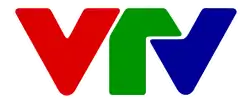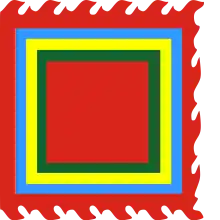Mass media in Vietnam
The mass media in Vietnam refers to the print, broadcast and online mass media available in Vietnam.
Television
Vietnam Television

The first television broadcasts in Vietnam were in the 1960s when the United States and South Vietnam set up two channels (one Vietnamese language and one in English) in Saigon.
The national broadcaster Vietnam Television (VTV) was established in Hanoi with technical assistance and training from Cuba in September 1970. VTV now is the largest television network in the nation, broadcast in nine FTA channels and available internationally via satellite. VTV also operates the largest cable network (VTVCab) and a DTH satellite service. These carry the nine FTA VTV channels: VTV1, VTV2, VTV3, VTV4, VTV5, VTV6, VTV7, VTV8, VTV9 ; twenty-three Vietnamese subscription channels: VTVCab1 (VIE Giải Trí), VTVCab2 (Phim Việt), VTVCab3 (Thể Thao TV), VTVCab4 (Văn Hoá/LOVE), VTVCab5 (E Channel), VTVCab6 (Hay TV), VTVCab7 (O2TV), VTVCab8 (BiBi), VTVCab9 (Info TV), VTVCab10 (VIE Dramas), VTVCab11 (TV Shopping, now Northern VGS SHOP), VTVCab12 (Style TV), VTVCab14 (Lotte Đất Việt Homeshopping, now VShopping), VTVCab15 (UM Channel), VTVCab16 (Bóng Đá TV), VTVCab17 (Yeah1 TV), VTVCab 18 (Thể Thao TV HD Tin tức), VTVCab19 (FilmTV), VTVCab20 (V Family), VTVCab 21 (BiBi+), VTVCab 22 (Life TV), VTVCab 23 (Golf TV) and about 45 local & international channels.

Vietnam Multimedia Corporation (VTC)
VTC operates five national channels and is the first provider of digital terrestrial television (DTT) in Vietnam. VTC's DTT service is a subscription service though unauthorized cloning of the signal is rampant.
VTC is a Vietnamese state-owned corporation under Ministry of Post and Telematics (currently the Ministry of Information and Communication) . It has 4 FTA channels, which is VTC1 - the generalist and news channel, VTC5 - the entertainment channel, TodayTV-VTC7 - the entertainment and series channel, and VTC9 -the Vietnamese entertainment channel, and a number of subscription channels including VTC2 - the economic & ICT channel, VTC3 - The sport & entertainment channel, VTC4 - the fashion and style channel, VTC6 - the movie channel, now North entertainment channel. Three new channels broadcast for examination in 2008 are VTC8 - the second VTC1, later became a financial channel, and later View TV, now the South Entertainment Channel, VTC13 the music channel, VTC11 - kids-oriented channel, and finally VTC12 - concurrently the Korean-language channel. Since 2010 VTC also launching three channels under deposit applications from the government, these are VTC10 - NETVIET, the cultural and foreign affairs channel, VTC14, Weather and Natural Disaster, and VTC16 (3NTV) - Agriculture-oriented channel
In 2006, VTC Mobile TV, one of the world's first subscription TV services for mobile phones, became available using DVB-H. It is operated by Vietnam Multimedia Corporation, owners of VTC.
From 1/1/2014, VTC Television Network separated from VTC Corporations and transferred to the Ministry of Information and Communication. From 27/6/2015 the network was transferred to the Radio the Voice of Vietnam and become the television enterprise agency of the network.
Local stations

These include Hanoi Radio Television and Ho Chi Minh City Television (HTV). The latter is available over most of the Mekong Delta.
Other subscription TV
Since 1991, hotels, restaurants, clubs, government offices and diplomatic organizations in Vietnam have been permitted under license to install and operate satellite dishes to bring in foreign programming. Nowadays, most of people in large cities (such as Hanoi and Ho Chi Minh City) subscribe to a cable network. The largest network is VCTV/VTVCab (a division of VTV), follows by that of Ho Chi Minh City Television (HTVC), Hanoi TV (HCATV/Hanoicab), and Saigon Tourist Cable Service (SCTV) - a joint venture between VTV and Saigon Tourist company. The latest payTV supplier is K+ which is a joint venture between Vietnam Cable Television (VTVCab) and Canal+, first broadcast in later 2009 via Direct To Home (DTH), and An Viên Television Service, owned by Audio Visual Global JSC, first broadcast in 2011 via both DVB-T2 digital terrestrial television (DTT) and Direct To Home (DTH)
Analog Television
Radio
.png.webp)
The first Vietnamese-language radio transmission was made on September 2, 1945, when Ho Chi Minh read out the Proclamation of Independence of the Democratic Republic of Vietnam.
Prior to 1945, Vietnamese people were banned from owning radio receivers, and broadcasting was under control of the French colonial government, which established the first radio station in Vietnam, Radio Saigon, in the late 1920s.
Vietnam's national radio station, now called the Voice of Vietnam, started broadcasting from Hanoi just a week after the declaration of the Democratic Republic of Vietnam. During the Vietnam War, Radio Hanoi operated as a propaganda tool of the Democratic Republic of Viet Nam.
South Vietnam set up its own network in Saigon in 1955.
Following Reunification, all of the radio stations were combined into the Voice of Vietnam, which became the national radio station in 1978.
Today, VOV strives to offer diverse, high-quality programming and in every aspect of mass media. It broadcasts on many channels, repeated on Medium wave (MW) AM, FM and shortwave (SW) AM bands throughout Vietnam and the rest of the world:
- VOV1 (MW, SW and FM) - news, current affairs and music
- VOV2 (MW, SW and FM) - cultural and social programs
- VOV3 (MW, SW and FM) - music & entertainment
- VOV4 (MW and SW) - ethnic minority language programming
- VOV5 (MW, SW and FM) - world service broadcasts in 11 foreign languages
- VOV6 (MW, SW and FM) - artistic-oriented programs, currently a block on VOV2
- VOV Transportation (FM) - updating information during rush hours to help people travel smoothly through traffic jams.
- VOV English 24/7 (FM) - English-language programs
- VOV 89 (FM) - health and safety consumering
- VOV News - a website containing news and other aspects
- VOVTV (Television Channel)- nationally broadcast which currently aimed at cultural and tourism programs
- VOV newspaper 'the Voice of Vietnam'- a printed version with more in-depth contents of VOVnews website
As of 2004, it was estimated that VOV's programs reached more than 90% of all households in Vietnam.
In addition, most cities and provinces has their own radio stations.
- *Vietnam Radio Stations Online Full List Updated 2013 Listen all Vietnam AM / FM Radio Stations Online
Newspapers
As Vietnam moves toward a free-market economy with its doi moi measures, the government has relied on the print media to keep the public informed about its policies. The measure has had the effect of almost doubling the numbers of newspapers and magazines since 1996.
The first Vietnamese-language newspaper was the French-sponsored Gia Định Bao, established in Saigon in 1869. In the years that followed, both the nationalistic and the colonial sides relied on newspapers as a propaganda tool. During the final period of French colonialism many reporters were arrested and imprisoned and several newspaper offices closed by the authorities.
For Ho Chi Minh's revolutionary side, Vietnamese journalists covered the First Indochina War. After the war, presses were set up in Hanoi and the basis for the country's newspaper industry as it exists today was formed, with the main Communist Party organ, Nhan Dan (The People), established in 1951.
Current large Vietnamese-language newspapers include Tuoi Tre (Youth, published in Ho Chi Minh City, described as a "reformist" newspaper), Thanh Nien (Youth), Người Lao Động (Labour or The Worker), Tien Phong (Vanguard), Sai Gon Giai Phong (Liberated Saigon), and Hànộimới (New Hanoi). Prominent French language newspapers included Saigon Eco, the only that currently is published is Le Courrier du Vietnam. There are other, smaller provincial newspapers such as the Ba Ria Vung Tau Daily Newspaper.
The largest online newspapers are Zing.vn, VnExpress, VietNamNet, Tuổi Trẻ, Thanh Niên, Dân Trí, VTC News, and VietnamPlus. The largest online news aggregator in Vietnam is Báo Mới.
See also
- Censorship in Vietnam
- Communications in Vietnam
- Culture of Vietnam
References
External links
- Vietnam Pictures - A rich collection of Vietnam pictures
- Việt Nam Cultural Profile - More information about broadcasting and Internet in Việt Nam
- Voice of Vietnam: State radio broadcaster, or VOV and VOV World Service
- rao vat: newspaper advertising
- VTV: State television broadcaster
- VTC: State digital TV station
- thue nha nguyen can: newspaper online room and real
- Vietnam News Agency: Official state news agency
- Tuoi Tre (Youth): daily newspaper with highest circulation (in Vietnamese)
- Tin tức VieTiger: daily online news & aggregation in Vietnamese
- TuoiTreNews: Popular English language newswire
- Vietnam Net: Popular online newspaper
- Chaobuoisang.net: Popular English Newspapers Online
- cho tot bat dong san: Newspapers real
- VnExpress: Popular online newspaper
- 24h.com.vn: Popular online newspaper
- Nhan Dan (The People): Official Communist Party newspaper
- Chaobuoisang.net Popular online news aggregator
- cho tot mua ban online news Buy and sale
- News.chaobuoisang.net: Popular English Newspapers Online
- phomuabannhadat: Online buy and sale newspaper
- phomuabannhadat: Online advertisement newspaper
- nha dat bat dong san: home and house newspaper
- mua ban rao vat: Online classic ads newspaper
- phomuabannhadat: Jobs newspaper hcm
- nhadat: homes newspaper
- tro tot: Newspaper room for rent
- bao bds: Online newspaper
- Vietbao CATV Official Site for Vietbao CATV
- VietBao Channels Vietbao CATV Channels and Program Schedule
- Baomoi.com Popular online news aggregator
- LinkHay.com Leading user-powered news network
- Xahoi.com.vn Popular online newspaper

